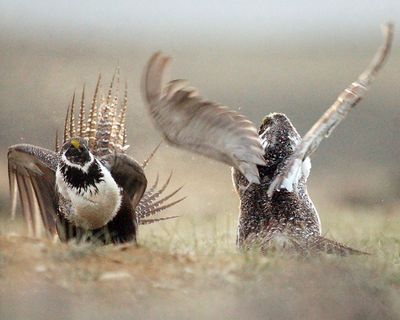Sage grouse conservation efforts huge

Knowing that the 1993 listing of the spotted owl as a threatened species hurt the logging industry, ranchers are getting aboard efforts to head off restrictions to their livelihoods.
The chicken-sized bird found in 11 Western states has been in decline over the past century because of the loss of sagebrush.
Federal protection could put restrictions on ranching – as well as energy production – but state and federal biologists say cattle and sage grouse can coexist if grazing is managed.
The agencies say the issue is larger than the grouse, which is considered an indication of the entire sagebrush steppe ecosystem in which it lives. While much of this land is public, mostly managed by the U.S. Bureau of Land Management, a large share is owned by ranchers.
The Bureau of Land Management, which controls 50 percent of the grouse’s sagebrush steppe habitat, is working on a court-ordered plan to protect the bird. A sage grouse endangered species listing could restrict development, energy exploration and ranching.
Sage grouse numbers declined sharply in the early 1900s and again after World War II. About 140,000 to 500,000 of the birds survive today, scientists estimate.
However, declines continue in some areas. Wyoming Game and Fish reported in January that the number of sage-grouse males observed on “leks” – open areas where they do mating dances – fell from 44,500 in 2006 to around 18,000 in 2013.
The 2-foot-tall creatures depend on sagebrush. About 50 percent of the West’s original sagebrush habitat was replaced by farms and communities, intentionally removed on federal lands or replaced by invasive cheat grass through frequent fires.
A partnership led by the Natural Resources Conservation Service is working with landowners to protect more than 25 million acres of private grouse habitat across 11 states.
In southern Idaho, conservation efforts for the sage grouse began in the early 1990s when Shoshone area ranchers formed a working group. More working groups were developed in 1997, including the Owyhee Working Group. By 2006, Idaho’s Department of Fish and Game and the state Office of Species Conservation had developed a plan that linked the conservation work of these local groups into a network.
Gov. Butch Otter is using the approach in his sage grouse strategy, which is the Fish and Wildlife Service’s “co-preferred alternative” for managing sage grouse on BLM lands.
“We have zoned the state so that (dollars) go where they need to go,” said Tom Perry, Otter’s chief counsel, who leads the sage grouse planning efforts.
Idaho Fish and Game plans to kill ravens in selected areas to give sage grouse chicks a short-term hedge against predation to increase populations.
The Sage Grouse Initiative, a coalition of public and private organizations, can tap federal money authorized in the farm bill. The program includes helping ranchers write prescribed grazing plans, mark fences so that grouse don’t fly into them, remove juniper, and retrofit cattle water troughs so grouse can get to the them.
Since 2010, the NRCS has obligated nearly $8 million for 99 projects on 437,000 acres of private and public lands, said Ron Brooks, the agency’s Sage Grouse Initiative resource conservationist.
Overall, the federal government paid $236 million to landowners in 11 states to preserve sage grouse habitat, the U.S. Department of Agriculture reported this week.
The Casper Star-Tribune reported that the money was paid for conservation efforts on nearly 6,000 square miles, mostly in the West, over a four-year period.
The Fish and Wildlife Service has until September 2015 to decide whether the sage grouse deserves protection.